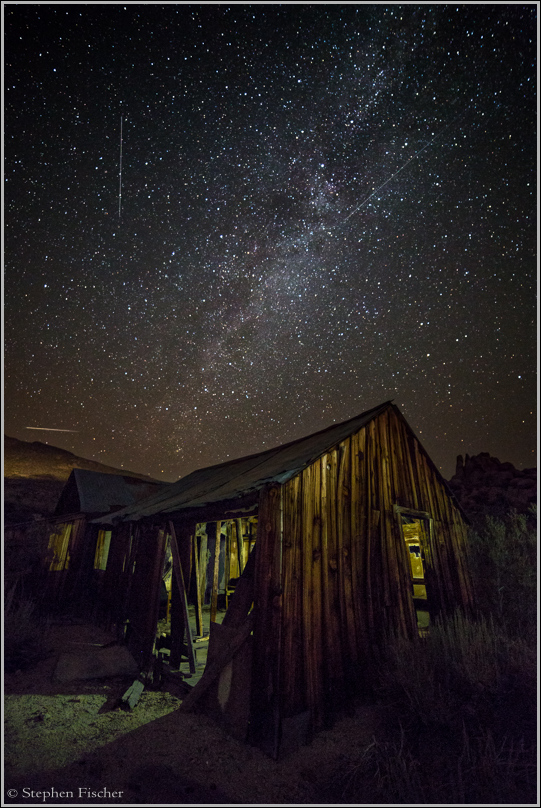Picture of the week

Night of the Perseids
A composition of an abandoned cabin with the backdrop of the Milky Way on the night of the Perseid meteor shower. I visited this location on the east side of the Sierras near Conway Summit with the plan to capturing the Perseid meteor shower with a more unique foreground composition. This needed to be sufficiently remote such that there would be a minimum of light pollution. The Rocky fire coming from the Kings Canyon area wafting over the Sierras ended up creating some haze in the night sky up through Owens Valley and further north past Mono Basin. But some light winds that evening helped to maintain some clarity.
This picture above is a composite of 4 separate images captured with the camera fixed
in the same position on a tripod and controlled with a cable release.
 The
camera used is a Canon EOS 5D mark III with a Samyang
14mm f/2.8 lens as set to ISO 6400. Image #1 was captured while light
painting the exterior of the building. Image #2 while light painting the
interior. Images #3 and #4 were captures of meteor trails while
letting the camera run on an intervalometer with 30 second exposures.
To the right is a separate less produced single image capture earlier in the
evening when the stars were just becoming visible. Note the distinctive
characteristic of the meteor trail with its brighter mid-section and
tapering on the end. Exposures of aircraft or satellite traffic will
have a more steady light trail without this tapering.
The
camera used is a Canon EOS 5D mark III with a Samyang
14mm f/2.8 lens as set to ISO 6400. Image #1 was captured while light
painting the exterior of the building. Image #2 while light painting the
interior. Images #3 and #4 were captures of meteor trails while
letting the camera run on an intervalometer with 30 second exposures.
To the right is a separate less produced single image capture earlier in the
evening when the stars were just becoming visible. Note the distinctive
characteristic of the meteor trail with its brighter mid-section and
tapering on the end. Exposures of aircraft or satellite traffic will
have a more steady light trail without this tapering.
I continue to find capturing a high enough frequency of meteor events for such a composition to be a challenge. Even though the Perseid shower is supposed to be the biggest of the year, at best visible meteor trails seem to occur every few minutes, and in different parts of the sky, and not all of them being as bright. The best strategy seems to be to point the camera toward the northeast, use an intervalometer with a 30 second exposure time and let it capture 50 to 100 images, and then selecting the best from your collection. If you expose for a longer period, then you will start getting star trails, while also reducing the sensitivity of the sensor for capturing the more faint meteor trails. Longer exposures also run the higher risk of being ruined by aircraft traffic flying across your field of view.
All content and images are property of Stephen Fischer Photography, copyright 2010-2015. Last updated: 8/23/2015 ()
 July
19, 2015
July
19, 2015 July
5, 2015
July
5, 2015 May
31, 2015
May
31, 2015 May
3, 2015
May
3, 2015 April
26, 2015
April
26, 2015 Apr
5, 2015
Apr
5, 2015 Mar
22, 2015
Mar
22, 2015 Mar
8, 2015
Mar
8, 2015 Feb 1, 2015
Feb 1, 2015 Jan
18, 2015
Jan
18, 2015